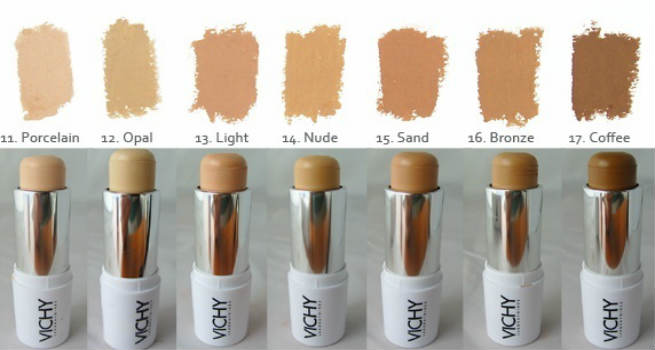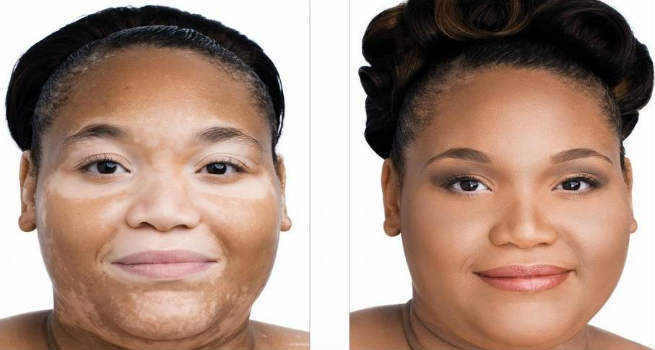Living with vitiligo can be challenging. While the condition is neither life-threatening nor contagious, the resulting disfigurement can be emotionally taxing. It’s important not to let the visible marks bring you down. Many embrace their white patches proudly, while others choose makeup to conceal vitiligo effectively. This article explores the causes, symptoms, and treatments and provides seven simple steps for adequate vitiligo coverage.
What is Vitiligo?
Vitiligo is a long-term skin disease affecting almost 0.5 to 2% of people worldwide (1). In this condition, you start developing light or white skin patches due to loss of pigment (melanin). It is typically caused by inactivity or destruction of the melanocyte cells, which are melanin-producing cells in our body. As melanocytes no longer produce melanin, the skin in that body part loses its color and turns white. Vitiligo is also a photosensitive condition, which makes the troubled parts of the skin more sensitive to sunlight than the rest of the body. It mainly affects the areas like the face, arms, hands, feet, nostrils, inside the mouth, back of the eyes, genitals, etc.
Causes of VItiligo
The precise causes of vitiligo remain unknown to scientists. Nevertheless, several potential factors contributing to this condition include autoimmune disorders, heredity, stress, genetic oxidative stress imbalance, severe sunburns, exposure to chemicals, neural complications, viral attacks, and other factors. (2)
Symptoms of Vitiligo
In vitiligo, flat white spots or patches of irregular shapes appear in an area of the skin often exposed to the sun. What looks like a tiny spot starts turning paler than the remaining part of the skin and eventually turns white. The spots’ edges get inflamed and turn slightly red, rarely accompanied by itchiness. Usually, the symptoms of vitiligo range from a handful of small white spots to larger white patches, based on individuals.
Vitiligo can be ‘non-segmental’ and ‘segmental’. Almost 90% cases of vitiligo are non-segmental in which semi-symmetrical patches develop in a very slow manner. In segmental vitiligo, the patches are mostly non-symmetrical and they spread more rapidly. (3)
Skin Camouflage Technique for Vitiligo
Skin camouflage is a non-invasive treatment that gives temporary yet fast results for vitiligo patients. This technique uses remedial cosmetic cover creams to disguise the vitiligo patches. Typically, a high concentration of pigment is added to anhydrous foundations to create a perfect shade of color that matches the tone of the patient’s skin. This is a great way to camouflage mild vitiligo, especially for dark-skinned individuals. It improves their quality of life and reduces their distress significantly by preventing them from being self-conscious. (4)
Read Also – Removing Pesky White Sunspots is Easy. Just Try These Simple Remedies!
How to Conceal Vitiligo with Makeup
You can conceal white vitiligo patches on your skin using good makeup products and simple tricks. Let’s see the steps to cover vitiligo with makeup so that nobody can even understand that you have it:
1. Choose the Right Foundation
The key to concealing vitiligo with makeup is finding the perfect shade of foundation. Make sure that the shade of your chosen foundation is closest to your skin tone or darker.
- There are many opaque foundations from brands like Microskin, ColorTradition, and Dermablend, specifically for skin afflicted with vitiligo. The ingredients used in such foundations are hypoallergenic and do not aggravate the skin condition.
- If you do not find the right specialized foundations, go for a regular full-coverage one (water-based or cream-based, depending on your skin type). Vichy has some fantastic high-coverage foundations with various skin tones and has worked for many women with vitiligo.
Read Also – How to Apply Liquid Foundation – Tips and Tricks
2. Prep Up the Skin
Once you are done with the selection of foundation, start with the most essential step, i.e., preparing your skin for the makeup. Cleanse the skin well with a mild cleanser (a herbal one is even better) that suits your skin, and moisturize it thoroughly with a high-quality moisturizing cream or lotion. Apply a primer all over the clean and moisturized skin to allow for easy blending and absorption of the foundation.
Always try to use a moisturizer that provides average to high sun protection along with intensive moisturization. A moisturizer with at least SPF 20 is a good choice to start with.
3. Apply Concealer and Foundation
As your skin is ready to use makeup, start concealing the white patches carefully. You must have picked a concealer that is a shade darker than your original skin tone. Make sure you apply it on the patches in small dots and blend well by moving your fingers in circular motions.
After that, top the concealer with the foundation you picked. Be careful with its application, as you need to follow a simple trick at this step. First, apply it precisely on the white patches and keep blending until they look even-toned. Once done, dot the foundation on the remaining part of your face and mix thoroughly to get a uniform skin tone. Let the makeup dry for about five minutes. Then, check the shade of your skin and apply another coat of foundation if need be.
You can apply foundation in multiple thin coats. Start from the centers of the white patches and work outwards as you blend it with your fingertips.
Read Also – Everything You Should Know About Vitiligo Prevention and Treatment
4. Powder Up to Even Out
Now, it is time to seal the makeup to ensure that the white patches stay hidden for an extended period. For this, dust some loose translucent powder all over your facial skin. It helps reduce unwanted shine by absorbing excess oil. It also helps in evening out the skin tone more efficiently. Press the powder well with a puff, then brush off the excess.
5. Use the Right Bronzer
After creating an even skin tone, it is time to get a more natural look with the help of a bronzer. Choose a product one shade darker than your natural skin color to emulate a beautiful sun-kissed glow. Apply it to the forehead, tip of the nose, and cheekbones until you get an illusion of a darker skin tone.
Read Also – Recipes of Natural Homemade Bronzer
6. Do Your Eyes and Lips
As you finish the face makeup, focus on the eyes and lips now. Highlight your eyes with your favorite kohl pencil and fill your lips with a striking lip color. This will draw the attention away from your skin and take it onto the eyes and the lips. However, keep your eye and lip makeup compatible with the makeup of your face to achieve a natural appearance.
7. Finish with a Fixing Spray
Finally, it is essential to keep the makeup in place by following all possible means so that the white vitiligo patches are not revealed after some time. Since you have used so many layers of makeup, spritz on a fixing spray all over the makeup to set it and prevent it from smudging.
Make sure to use waterproof makeup products if you tend to sweat a lot. Also, it is important to remove the makeup at the end of the day.
Available Treatment Options for Vitiligo
According to the American Academy of Dermatology (AAD), vitiligo is more than just a cosmetic issue (5), and its visibility should be reduced with the help of the following remedies:
- Sunscreen: Prevents the photosensitive lighter patches on the skin from burning (6)
- Phototherapy with UV Light: The affected part of the skin is exposed to ultraviolet lamps (both UVA and UVB) for re-pigmentation
- Depigmentation: Involves the application of topical solid creams containing monobenzone, hydroquinone, mequinol, etc., for depigmenting the unaffected parts of the skin
- Topical Corticosteroid: Stops the white patches from spreading and restores them to their original color
- Calcipotriene (Dovonex): This vitamin D ointment is used in combination with corticosteroids
- Skin Grafting: A surgical procedure in which the affected parts are covered by healthy patches of pigmented skin
- Tattooing: In this method, the pigment is implemented into the patchy areas of the skin surgically
Read Also – 7 Natural Home Remedies for Vitiligo to Banish White Patches Easily
Summary:
Vitiligo is an autoimmune disorder that needs extended periods of treatment to fade away completely. However, while battling the disorder with medicines or home remedies, you can also opt for makeup as instant and temporary solutions. But it is essential not to lose self-confidence in any condition if you have visible patches on your face or hands.
Frequently Asked Questions (FAQs)
How Long Does Skin Camouflage Last for Vitiligo?
If the right products are applied correctly, skin camouflage results can last around 12-18 hours on the face and almost 96 hours on the rest of the body.
Does Dermablend Cover Vitiligo?
Dermablend is a dermatologist-recommended brand for vitiligo makeup. It offers high-performance foundation & concealer products that can cover vitiligo patches beautifully. The products are also non-comedogenic, sensitive-skin tested, allergy-tested, and fragrance-free.
Is Sunlight Bad for Vitiligo?
As vitiligo makes the affected parts of the skin photosensitive, it is essential to keep those areas protected from the sunlight. It is even more true in the case of people with fair skin.
How Fast Does Vitiligo Spread?
Well, this cannot be predicted. For some people, vitiligo does not spread; for others, it has spread slowly for many years.
Is Vitiligo a Form of Leprosy?
No, vitiligo is in no way linked to leprosy. It is non-contagious and non-infectious.
Also Read – 10 Best Bronzers in India to Flaunt That Natural’ Holiday Glow’
References:
- “A Review of the Worldwide Prevalence of Vitiligo in Children/Adolescents and Adults,” ncbi.nlm.nih.gov
- “Evidence for an Autoimmune Pathogenesis of Vitiligo,” ncbi.nlm.nih.gov
- “Understanding the Symptoms of Vitiligo,” MedicalNewsToday.com
- “Cosmetic Camouflage in Vitiligo,” ncbi.nlm.nih.gov
- “Is Vitiligo a Medical Condition?“, AAD.org
- “Vitiligo Discomfort Stops with Sunscreen Use,” AAD.org
Medically Reviewed by Dr. Keira Barr. Dr. Keira is a dual-board certified integrative dermatologist, certified as an Advanced Practitioner of Mind-Body Medicine, and a trauma-informed life coach.


